mobile View, to the German Version tap the flag


- 1796–1893 Kingdom
- 1894–1898 Republic
- 1898 annexed by the USA
- since 1959 federal state of the USA
• Flags
• Historical Flags
• Flag of the independence movement
• Meaning/Origin of the Flag
• Coat of Arms
• Map
• Numbers and Facts
• History
• Origin of the Country's Name
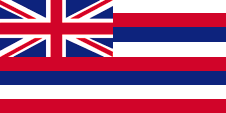
State flag,
Source, by:
Wikipedia (D)






Flag of the governor,
Source, by:
Wikipedia (D)




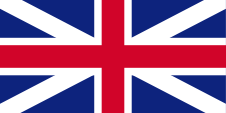
1793–1801,
Flag of United Kingdom,
ratio = 1:2,
Source, by: Wikipedia (D)






1801–1816,
Flag of United Kingdom,
ratio = 1:2,
Source, by: Wikipedia (D)





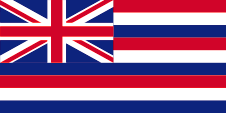
1816–1843,
Flag of the Kingdom of Hawaii,
ratio = 1:2,
Source, by: Wikipedia (D)




1843–1893,
Flag of the Kingdom of Hawaii,
ratio = 1:2,
Source, by: Wikipedia (D)





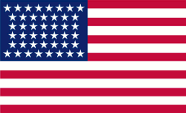
1893–1894,
Flag of the USA,
Source, by: Wikipedia (D)




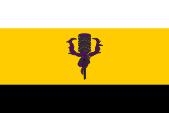
Flag of the independence movement,
Source, by:
Stateless Nations,
hawaii-nation.org




detail of the flag of the independence movement,
Source, by: hawaii-nation.org
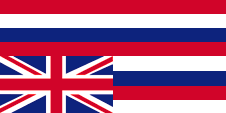
Flag of the independence movement,
Source, by:
Wikipedia (EN)






The flag of the US federal state Hawaii correspond to the flag of the Kingdom of Hawaii, which was introduced in 1843. It shows eight stripes in white, red and blue. They stand for the eight biger islands of the archipelago. A nearly similar flag was created in 1816 by king Kamehameha I. The stripe-design should remember the flag of the USA. The upper canton shows the British Union Jack. It stands for the good connections of Hawaii to United Kingdom and remembers the British colonization. The design of the flag had been chosen quite aware to emphasize in this way the good relationships with both – the USA and United Kingdom – even and precisely because these two powers were at that time in war with each other. Despite the fall of the monarchy and the step by step done annexation of the islands by the USA the flag was maintained until today. The Hawaiian independence movement uses partially a white-golden-black flag, obvious native colours, added in the middle stripe by native symbolism. Other parts of the movement use the current flag, but reversed.
Source:
Wikipedia (D),
World Statesmen,
lahaina.de


Coat of Arms (seal) of Hawaii,
Source, by: By Sodacan (With elements from File:Hawaii-StateSeal.svg, uploaded by: Clindberg)This vector image was created with Inkscape. [CC BY-SA 3.0, Public domain or Public domain], via Wikimedia Commons

Map of the country:
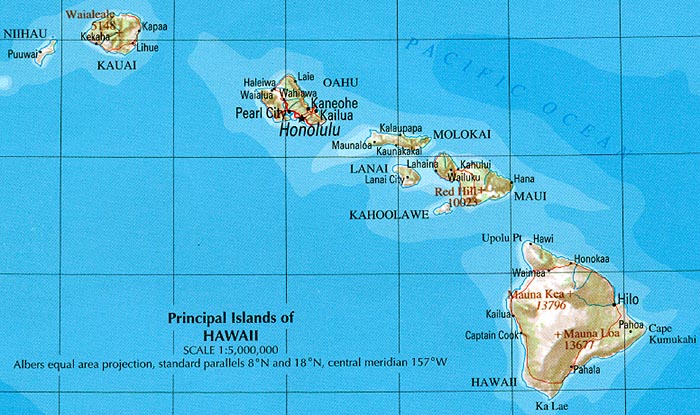
Source: yellowmaps.com University of Texas

Area: 6.419 square miles
Inhabitants: 1.455.271 (2020), davon 24% Europeans, 17% Japanese, 14% Philippinos, 7% Hawaiian, 5% Chinese
Religions: 38 % Protestant, 19 % Catholics, 8 % Buddhists, 5 % Agnostic, 2 % non-religious
Density of Population: 227 inh./sq.mi.
Capital: Honolulu, 343.302 inh. (2020)
official Languages: English and Hawaiian
Currency: US-Currency
Time Zone: GMT – 10 h
Source: Wikipedia (D)

ca. 750 B.C. · initial Polynesian settlement
1535 · the Spaniard Juan Gaeatano discoveres and explores Hawaii
1778 · James Cook discovers the islands Oahu and Kauai and names the whole archipelago "Sandwich Islands" (Sandwich = name of a Lord of the British admiralty)
1779 · Cook gets killed in fights on the islands
1789–1810 · the king of the Island Hawaii Kamehameha I. enforces wars against the neighbouring islands
1796 · Kamemeha I. proclaims the Kingdom of Hawaii, and leans strong close to the USA andUnited Kingdom
1826 · first trade treaty between the USA and Hawaii
1843 · United Kingdom terminates his engagement for and on Hawaii
1848 · the USA occupy and annex the Midway Islands
1849 · first state treaty between the USA and Hawaii
1851 · the Kingdom of Hawaii becomes an unofficial protectorate of the USA
1858 · the Kingdom of Hawaii intends officially an annexation by the USA
1875 · further trade treaty between the USA and Hawaii
1886 · wanted settlement of 180.000 Japanese contract workers on the islands
1887 · the USA establish a navy base in Pearl Harbour
1889 · failed coup d'état against the king
1891 · king Kalakaua dies, his sister Liliuokalani follows hin into the function
1892 · US-American plantation owners plan a coup d'état against the queen
1893 · the queen becomes declared for dismissed, the US-American S.B.Dole gets appointed to the chief of government
1894 · proclamation of the republic, S.B.Dole becomes president
1895 · failed coup d'état by the former queen of Hawaii
1898 · Hawaii is annexed by the USA
1900 · Hawaii is a Territory of the USA
1917 · Liliuokalani, the former queen of Hawaii dies
1922 · the royal house of Hawaii extincts
1937 · the US congress rejects a status of statehood for Hawaii
7th of December 1941 · Japanese attack on Pearl Harbour, the USA declare Japan the war
1959 · Hawaii gets officially the 50th federal state of the USA
Source:
Atlas zur Geschichte,
Wikipedia (D),
Discovery '97

The name of the country goes back to the largest island of the archipelago. From here, King Kamehameha I. conquered all the other islands of the island group with the help of United Kingdom until 1810, and thus the name of his island kingdom became transferred to the entire archipelago. The island of Hawaii is the largest of the islands in the archipelago. It is also called "Owyhee" or "Big Island". In the Polynesian languages, the words Hawai'i or Havaiki mean "seat of the ancestors". However, the word has in the Polynesian language of the Hawaiian Islands no meaning (anymore). When James Cook discovered the archipelago in 1778, he named the entire island group of the today's Hawaiian Islands "Sandwich Islands", according to John Montagu, 4th Earl of Sandwich, the Lord of the British admiralty.
Source:
Wikipedia (D)


![]()
























